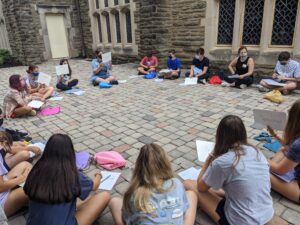by Arianna Frantz, Temple Sholom
 From the beginning of the introduction workshop until the end, I learned a lot of useful information ranging from how to help students to where my responsibilities as a teaching assistant will lie. At the beginning of the workshop, we introduced ourselves and played some icebreakers, before being asked how we could make those icebreakers accessible to everyone or give students a bit more help. One example of an icebreaker was lining up by birthday month and day without speaking. We said using whiteboards or playdough to shape numbers would help make lining up silently easier. This is helpful in finding ways to make everyone inclusive and a useful tool in any classroom, especially if the students are young and can have a hard time figuring out how to solve a problem.
From the beginning of the introduction workshop until the end, I learned a lot of useful information ranging from how to help students to where my responsibilities as a teaching assistant will lie. At the beginning of the workshop, we introduced ourselves and played some icebreakers, before being asked how we could make those icebreakers accessible to everyone or give students a bit more help. One example of an icebreaker was lining up by birthday month and day without speaking. We said using whiteboards or playdough to shape numbers would help make lining up silently easier. This is helpful in finding ways to make everyone inclusive and a useful tool in any classroom, especially if the students are young and can have a hard time figuring out how to solve a problem.
Later on in the program, we were given a blank piece of paper and told basic instructions, such as “fold the paper” and “cut the left corner”. We weren’t told which way to fold or cut, and we weren’t allowed to ask questions or look at others. In the end, we all created different products. This was an example of bad teaching, and we were asked how we could tell a teacher or help a student to make the instructions more clear. We came up with ideas such as writing the instructions down or asking questions about the instructions in the student’s place. After this, we were given instructions on a paper and the teacher came around and helped us when needed. This was an example of good teaching, and how to make clear instructions for students to understand. I think this is very helpful, because almost everyone has experienced frustration or helplessness because of unclear instructions, and often when instructions are followed incorrectly, whether it’s the teacher’s fault or the student’s, someone gets blamed and feels upset. Making sure the students can follow and understand these instructions given is the first step to getting an activity done in a way that won’t end in negative feelings.
Like the beginning of the introduction workshop, near the end we drew random items from a bag and had to find use from them. We drew things like post-it notes, balloons, and reading highlighters. We came up with classroom activities, memorization, and focusing and or fidgeting as uses for different items.
All of these activities will be extremely helpful in my classroom, especially since we’ll be working online and not all of the students will want to focus. I’ve learned a lot about how to engage my students and to better help my teacher. All information that will serve me well in almost any situation, not only in my classroom.



